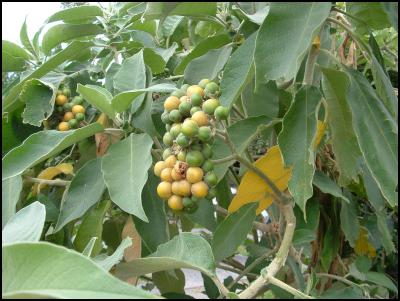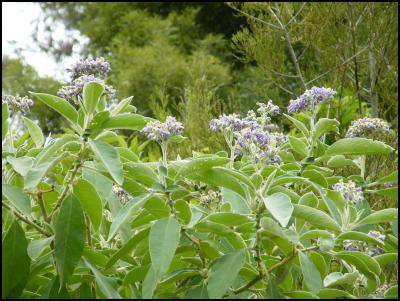Check for Woolly Nightshade
Media Release
9 May 2017
Check for Woolly Nightshade

Woolly nightshade fruit,
photo Weedbuster
Hawke’s Bay residents are asked to check for Woolly nightshade plants in gardens, wasteland areas and roadsides and report any plants found to Hawke’s Bay Regional Council Biosecurity team.
Woolly nightshade is a fast-growing and extremely invasive plant that is widely spread throughout the region’s gardens, roadsides, and rank pasture. It is also a health hazard, as people handling it may suffer nausea and irritation of the skin and respiratory tract.
“We want to keep a check on this plant, especially because of the health concerns. We’ve never found it in huge numbers, but as it will grow almost anywhere in Hawke’s Bay we don’t want it spreading, like it has further north,” says Alice McNatty, HBRC biosecurity officer.
“When people contact us, we’ll come out and kill the plant at no cost to the landowner. We will also advise them on how to control any seedlings that might pop up.”
Ms McNatty says that the shrub is flowering at the moment, so can be more easily identified by its lilac flowers. Some plants may also be fruiting at present and it is important to ensure the berries don’t get into compost or weed piles. Woolly nightshade can quickly grow into a small tree up to 10 metres high and become more difficult to remove, so it is better to identify it and deal with it early.

Woolly nightshade flowering,
photo Weedbusters
Woolly nightshade - also known as tobacco weed, kerosene plant, flannel weed and eared nightshade - can be identified by its distinctive hairy, oval leaves, and small, pretty lilac flowers which are massed in clusters at the ends of branches. It forms green berries up to 18mm in diameter which yellow when ripe. Seedlings that establish in spring can flower by autumn and continue flowering.
Hawke’s Bay residents can report a woolly nightshade plant by contacting HBRC’s Biosecurity team Alice McNatty 06 833 8083 or Louise Hampton 06 833 8023. If staff are unavailable, residents can leave a message including name, phone number and address of the plant location.
More information on this plant and other plant pests is on the national Weedbusters websitewww.weedbusters.org.nz.


 Gordon Campbell: On When Racism Comes Disguised As Anti-racism
Gordon Campbell: On When Racism Comes Disguised As Anti-racism Green Party: Government Throws Coal On The Climate Crisis Fire
Green Party: Government Throws Coal On The Climate Crisis Fire Labour Party: Public Transport Costs To Double As National Looks At Unaffordable Roading Project Instead
Labour Party: Public Transport Costs To Double As National Looks At Unaffordable Roading Project Instead The Treasury: New Paper On A Framework For Assessing The Economic And Fiscal Impacts Of Climate Change
The Treasury: New Paper On A Framework For Assessing The Economic And Fiscal Impacts Of Climate Change Government: Pet Bonds A Win/Win For Renters And Landlords
Government: Pet Bonds A Win/Win For Renters And Landlords Government: New Zealand Condemns Iranian Strikes
Government: New Zealand Condemns Iranian Strikes Environmental Defence Society: Calls For Fast-track Approvals Bill To Be Abandoned In Submission To Select Committee
Environmental Defence Society: Calls For Fast-track Approvals Bill To Be Abandoned In Submission To Select Committee


